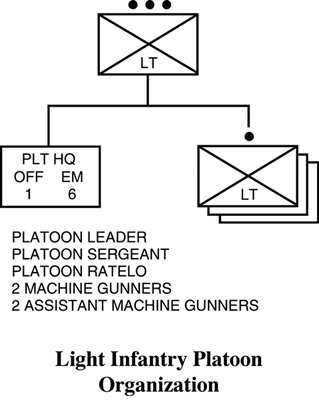
The most common rifle squad has nine soldiers and fights as two rifle teams. The squad has one squad leader, two rifle team leaders, and (if weapons are available) two automatic riflemen (M249 SAW), two riflemen (M16), and two grenadiers (M203).
ORGANIZING FOR COMBAT
In order to organize your unit as a fighting infantry platoon or fighting force, you have to take a look at and analyze your personnel and equipment. Organize your force based on the number of personnel you have. If you only have thirteen people, you might consider just replicating a large infantry squad with three fire teams (you can also have two larger fire teams) or one infantry squad with a machine gunner and an antiarmor specialist.
Additionally, you have to look at your available weapons and determine who is best at using machine guns or antiarmor weapons if you have them available. Often soldiers are assigned more than one weapon, such as an M16 rifle while also responsible for a crew-served machine gun mounted on the vehicle. Assign someone the duties of machine gunner in the event your element has to dismount and fight. There is no right or wrong way to organize your element; just ensure your personnel know their assigned duties and their assigned weapon system(s). When time presents itself, conduct the necessary individual and unit training that is most critical to your survival in the event you get into a firefight.
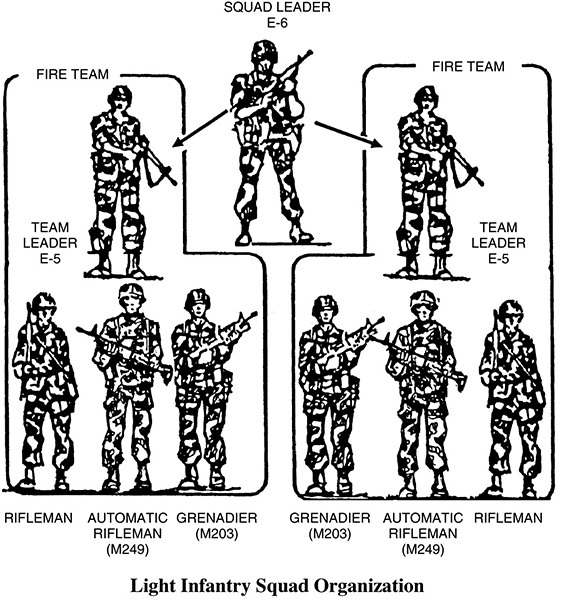
DUTIES AND RESPONSIBILITIES
The rifle squad leader is responsible for the squad. He is a tactical leader and leads by example. He controls his squad’s movement, rate, and distribution of fire. He controls two fire teams in the offense; selects each fighting position in the defense; and gives the commands and signals to commence, cease, and shift fires. He briefs the squad on orders, trains the squad, manages the squad’s administrative and logistical needs, is responsible for accountability and maintenance of personnel and equipment, and keeps the squad fit to fight.
The team leader controls the movement and fires of the fire team. He assists the squad leader in tactical control of the squad and in training team members on individual and collective tasks and battle drills. The team leader sends reports as requested to the squad leader when his team makes contact. The team leader controls fire and distribution for his team by designating and marking targets.
The grenadier is equipped with an M203 weapon system consisting of an M4/M16 rifle and an attached 40mm grenade launcher. The M203 allows him to fire high-explosive rounds to suppress and destroy enemy infantry and lightly armored vehicles. He also can employ smoke to screen and cover his squad’s movement, fire, and maneuver. During night and adverse weather conditions, the grenadier also may employ illumination rounds to increase his squad’s visibility and mark enemy or friendly positions. The grenadier provides the fire team with an indirect-fire capability out to 350 meters.
The automatic rifleman’s primary weapon is the M249 squad automatic weapon (SAW). Each infantry squad has two automatic weapons. The M249 provides the squad with a high volume of sustained long-range suppressive and lethal fires far beyond the range of the M16/M4 rifle. The gunner employs the SAW to suppress enemy infantry and bunkers, to destroy enemy automatic rifle and antitank (AT) teams, and to enable other teams and squads to maneuver. If a unit does not have a SAW, the next best thing is to designate the automatic riflemen in the squad and have them use the burst mode on their rifles to accomplish rapid fire.
The rifleman is armed with an M4 or M16A2 5.56mm rifle. He is employed at the direction of the team leader.
The antiarmor specialist is equipped with the Javelin AT missile system, M47 Dragon, or even the M136 AT-4. The available AT weapon system destroys enemy armor threats that may impede the platoon’s or unit’s progress, or it can be employed to destroy other targets of opportunity. The Javelin provides the squads, platoon, and company with a lethal, fire-and-forget, man-portable, top-attack antiarmor capability to defeat enemy main battle tanks during day, night, and adverse weather conditions at ranges up to 2,000 meters.
The machine-gun crew consists of three personnel: the gunner, assistant gunner, and ammunition handler. The gunner is the senior member of the crew and responsible for putting the gun in and out of action. The assistant gunner supports and replaces the gunner in his absence. The ammunition handler carries the spare barrel and additional ammunition for the machine gun and provides local security for the machine-gun crew with his assigned rifle.
Appendix F
Organic and Supporting Weapons
ORGANIC WEAPONS
Organic weapons are those assigned to the platoon over which the platoon leader has direct control. Every leader must know how to employ these weapons effectively in all tactical situations. Additionally, the infantry platoon routinely uses antiarmor weapons, hand grenades, and mines. The following tables outline some of the key organic weapon systems available to the modern infantry platoon.
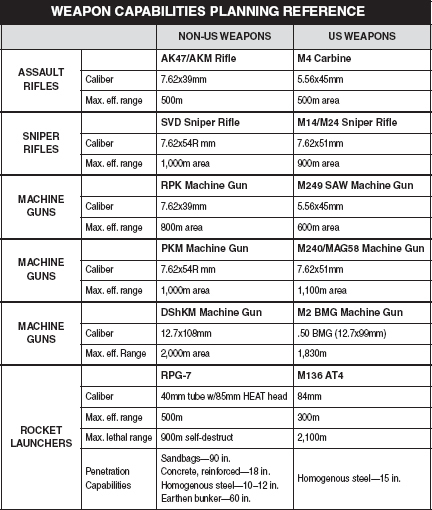
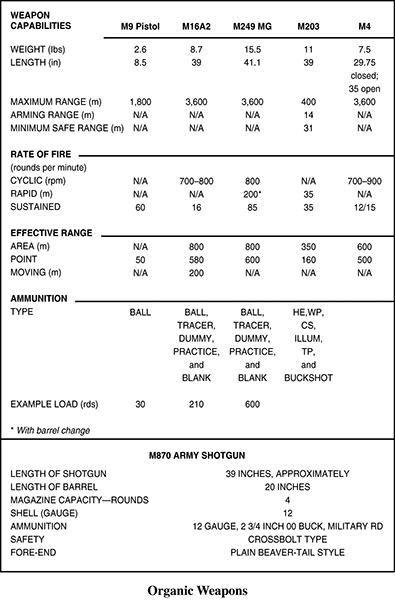
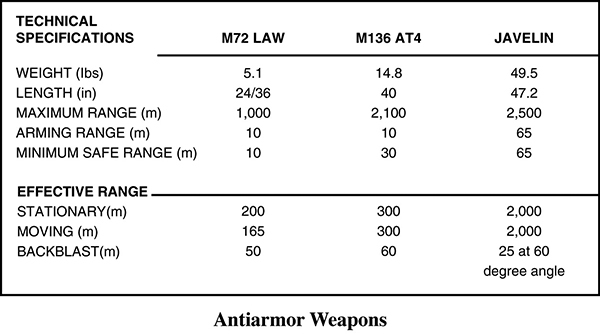
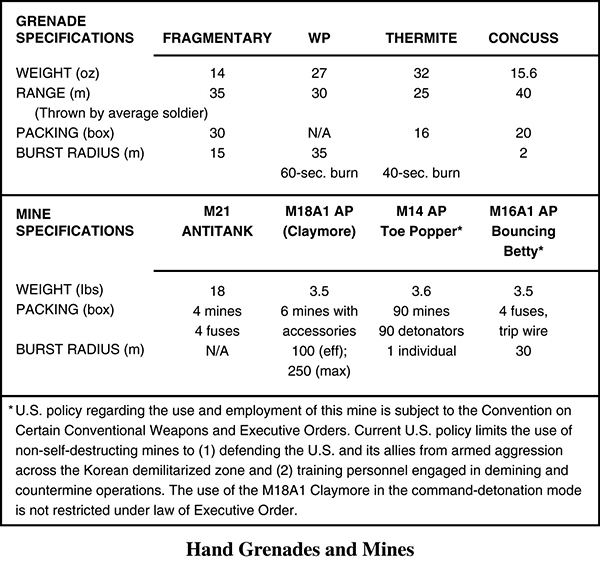
SUPPORTING WEAPONS
Supporting weapons provide the platoon and squad leaders with additional firepower. Leaders must know how to effectively integrate the fires of these weapons with the fires of their organic weapons. The following tables outline some of the key supporting weapon systems available to the modern infantry platoon:
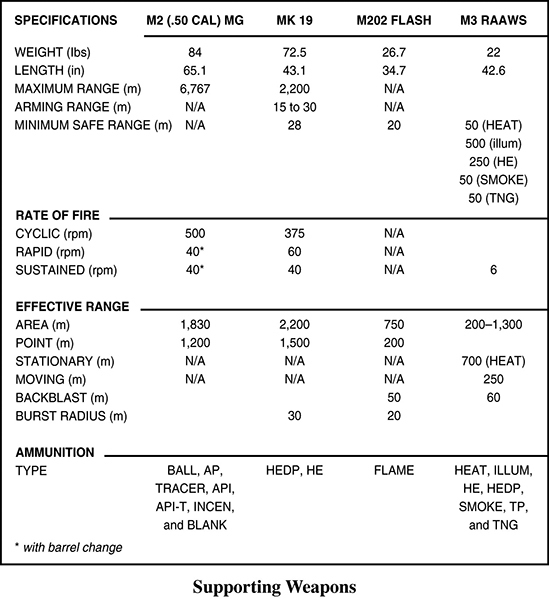
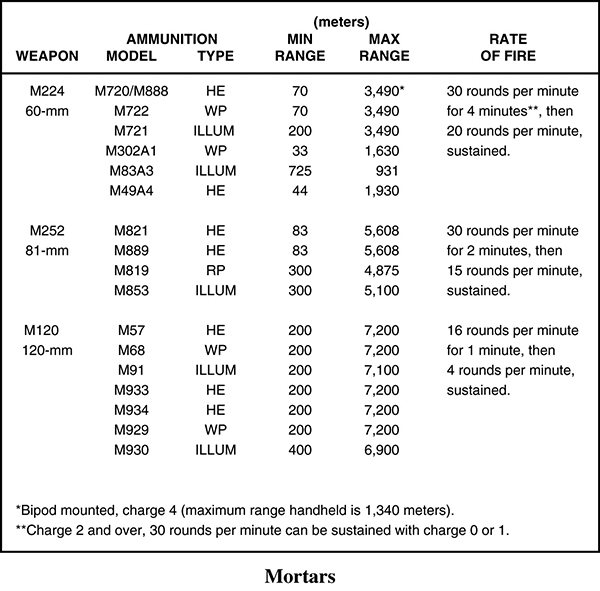
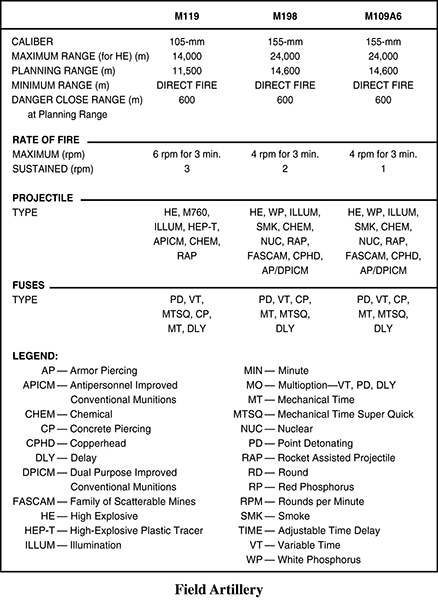
G
Body Armor Levels
All armor has a shelf life of approximately five years, but less if it is:
•Exposed to UV sunlight.
•Exposed to excessive heat (over 100 degrees).
•Exposed to dirt.
•Dropped, which will crack the ceramic plates.
•Exposed to general abuse.
NATIONAL INSTITUTE OF JUSTICE (NIJ) RATINGS FOR BODY ARMOR
Level IIA (Lower Velocity 9mm, .40 S&W)
This armor protects against 9mm Full-Metal-Jacketed Round-Nose (FMJ RN) bullets with nominal masses of 8 grams (124 grain) impacting at a minimum velocity of 332 m/s (1090 ft/s) or less and .40 S&W caliber Full-Metal-Jacketed (FMJ) bullets with nominal masses of 11.7 grams (180 grains) impacting at a minimum velocity of 312 m/s (1025 ft/s) or less. It also provides protection against Level I threats. Level IIA body armor is well suited for full-time use by police departments, particularly those seeking protection for their officers from lower velocity .40 S&W and 9mm ammunition.
Level II (Higher Velocity 9mm, .357 Magnum)
This armor protects against .357 Magnum jacketed soft-point bullets with nominal masses of 10.2 grams (158 grain) impacting at a velocity of 425 m/s (1,395 ft/s) or less and against 9mm full-jacketed bullets with nominal velocities of 358 m/s (1,175 ft/s). It also protects against most other factory loads in caliber .357 Magnum and 9mm, as well as the Level I and IIA threats. Level II body armor is heavier and bulkier than either Levels I or IIA. It is worn full time by officers seeking protection against higher-velocity .357 Magnum and 9mm ammunition.